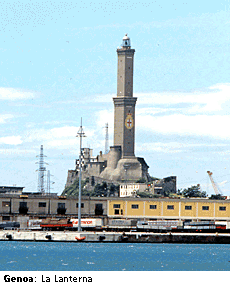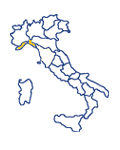Historical buildings and monuments
La Lanterna
The ancient lighthouse of Genoa, symbol of the city, was erected in 1543. The tower reaches a height of 117 meters, and the view from its pinnacle is one of the most beautiful in the city.
Villa Doria-Pamphilj
The construction of the Palazzo del Principe was begun by Andrea Doria in 1529, just outside the city walls. Influenced by the Renaissance culture of Rome, this palazzo signaled the architectural transition from the Medieval to the Renaissance in Genoa, pre-dating the palazzos of Strada Nuova. Still today the property of the Doria Pamphilj princes, the palazzo was opened to the public after a long period of restoration.
Among the many rooms open to visitors, some of the most notable are the Carità Romana hall, the Caduta dei Giganti salon, the Perseo room, the Sacrificio room, the Cadmo room and the Zodiac room. Make sure not to miss the Galleria Aurea, with its rare tapestry cycle.
Information: +39 010 255509
Palazzo Reale (royal Palace)
The palazzo, built in the 17th century by the Balbi family, was transformed into a baroque edifice modeled on Roman palazzos. In 1825 it became the residence of the Reale Savoia family. Today the palazzo is a museum-residence open to visitors, with a series of elegant furnished rooms and works of art which were set up by the Durazzo family in the 18th century and by the Reale family in the 19th century. Outside the palazzo are lovely gardens, lush with greenery and exotic foliage.
Schedule: Tuesday and Wednesday, 9:00 a.m. to 1:00 p.m.; Thursday through Sunday, 9:00 a.m. to 7:00 p.m.; Closed Mondays.
Information: telephone: +39 010 2710236
The buildings at Strada Nuova
Strada Nuova (the present-day via Garibaldi) was opened in the 1500's in a peripheral urban area, not far from the commercial center. This new, lovely and elegant street reflected brightly upon the most wealthy and powerful families of Genoa, who made it their own residential quarter. This long road winds alongside luxurious palazzos, with their grand atriums, staircases, courtyards, outdoor halls and hanging gardens -- innovations never before seen in the Genoa of that time.
Today, via Garibaldi is home to the most outstanding set of museums in Genoa, including exceptionally important picture galleries such as Palazzo Rosso, Palazzo Bianco, and Palazzo Spinola. See Museums and Galleries.
Piazza San Matteo
Located in this small piazza in the heart of the medieval center are the palazzos of the Doria family, leaders of political life in Genoa for centuries. These include: the Palazzo di Branca Doria (street address 13), the Palazzo che Lamba Doria (street address 15), the Palazzo Domenicaccio Doria (street address 16), and finally the home of Andrea Doria (street address 17), gifted to him by the Senate of the Republic for his role as "Salvatore della Patria" -- savior of the nation. These palazzos are all highly decorated, and display distinctive white and grey bands of marble.
Palazzo San Giorgio
Palazzo San Giorgio, unfortunately disfigured by an ugly elevated highway, was the fulcrum of commercial and maritime activity in Genoa for centuries.
The original edifice was built in 1260 as a Palazzo del Comune (town hall). In 1451, the palazzo became the home of Banco di S. Giorgio, one of the most powerful banks in Europe, which managed the finances of the Republic of Genoa until the 17th century. According to tradition, Marco Polo, confined in the prison that was once located in this palazzo, dictated "Il Milione" to Rustichello da Pisa, his cellmate, after the victory of the Genoese at the Battle of Meloria.
Porta Soprana and Colombus' House
This city gate, which was built in the same era as its twin, Porta dei Vacca (1161), is enclosed between two battlement towers. The port was the main entryway into the Medieval city from the east. Right next to Porta Soprana lies the building known as the Casa di Colombo (Columbus's House). In reality, this moniker is historically inaccurate. The building was constructed at the end of the 17th century, having been built upon the remains of Christopher Columbus' real house, which was destroyed in a naval bombardment by the French in 1684.
The votive tabernacles
These religious objects are numerous, scattered throughout the historic center of the city. Since Medieval times, the Genoese have been fond of protecting their homes and their work with sacred images, depicted on slate or sculpted from marble, and placed in niches or tabernacles. Some of these were commissioned to famous artists, who created true works of art from these religious objects. More than 330 were constructed in Genoa, and today many of them have been restored.
Go to directories of the Web Sites
|



